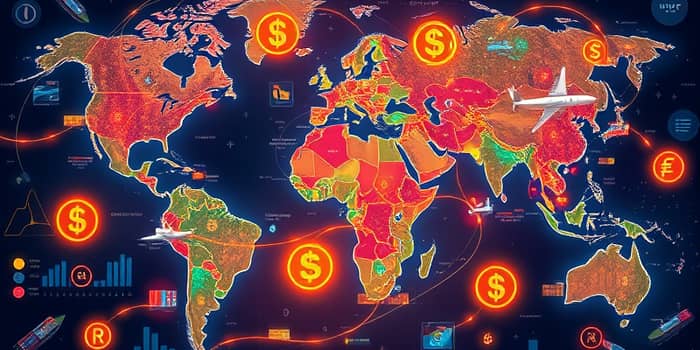
In an interconnected world, the ebb and flow of currencies shape the fortunes of businesses, nations, and consumers alike. As exchange rates shift, they create both opportunities and challenges across the global marketplace.
Currency fluctuations serve as a catalyst and a challenge for international commerce. When a currency weakens, exporters find new markets suddenly more accessible; when it strengthens, importers reap cost advantages. Yet volatility can also disrupt planning, erode profit margins, and fuel heightened global uncertainty.
In 2025, stakeholders from Washington to Mumbai are watching rates closely. Forecasts from the International Monetary Fund (IMF) and World Trade Organization (WTO) warn of increased trade uncertainty, as volatile markets collide with political tensions and supply chain vulnerabilities.
Exchange rates spring from a blend of market dynamics and policy interventions. Broadly, systems fall into two categories:
Underlying these systems are key determinants:
Recent data underscore a muted trade environment:
Tariffs, supply chain disruptions, and rising policy uncertainty are cited as principal drags. Least-developed economies face the sharpest headwinds, risking deeper inequality and slowed poverty reduction efforts.
Currency swings ripple through both export and import channels:
For exporters, a weaker domestic currency lowers overseas prices, as seen in India’s textile and agricultural sales in early 2025. Yet a sudden appreciation can reverse gains overnight, forcing firms to absorb or pass on costs.
For importers, a strong home currency makes foreign goods more affordable, benefiting consumers but increasing competitive pressure on local manufacturers. Conversely, weakness in the domestic unit can stoke inflation by raising input costs.
Tariffs and currency shifts often work at cross-purposes. A 10% import levy may be neutralized if the exporting nation’s currency depreciates by a similar margin, illustrating how exchange dynamics can offset policy aims.
Central banks wield several levers to manage exchange rates and financial stability:
History teaches that credibility matters. Half-hearted interventions or sudden policy reversals can deepen volatility, as observed in new-currency transitions and some post-Soviet states.
Exchange rates do not operate in isolation. They mirror broader financial conditions:
Tight global liquidity or investor pessimism can trigger rapid capital outflows, forcing currencies to repricing. Commodity price swings—especially in energy and agriculture—further amplify effects, particularly for resource-dependent nations.
Persistent trade surpluses may foster a stronger currency, but they risk pricing domestic firms out of global markets. Deficits can exert downward pressure, yet also reflect robust domestic demand for imports.
Dense cross-border value chains magnify currency shocks. Intermediate goods traverse multiple nations before final assembly; a shift in one currency can cascade through the entire chain, raising costs and delaying deliveries.
This supply chain multiplier effect underscores the importance of resilient sourcing strategies and diversified production footprints.
Stakeholders must adapt with foresight and flexibility:
Effective coordination between fiscal, monetary, and trade policies can avert self-defeating cycles of volatility and protectionism.
Ongoing geopolitical tensions, policy uncertainty, and technological disruptions pose significant risks. Yet, credible monetary frameworks and well-managed currency regimes can allow nations to absorb external shocks and maintain growth.
By understanding how exchange rates shape costs, competitiveness, and consumer welfare, businesses and governments can chart paths toward more stable and inclusive trade.
Ultimately, in a world of interconnected markets, exchange rate management remains a vital tool for promoting macro stability and growth, ensuring that the engine of global commerce continues to drive prosperity.
References













